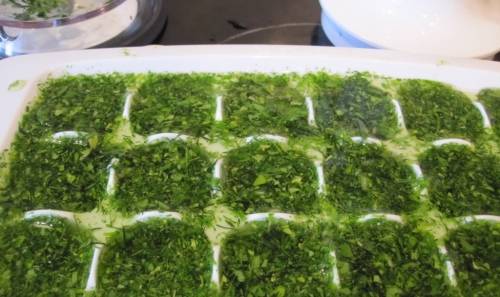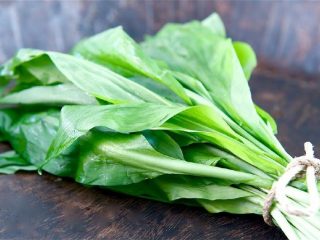Content
Many housewives use aromatic, fragrant and very healthy greens when preparing first and second courses. In summer it can be found in abundance in garden beds, but in winter it is available fresh only on store shelves and its prices are by no means low. Fortunately, some housewives have come up with recipes on how to prepare greens for the winter. By performing simple manipulations, you can maintain the quality and benefits of this universal ingredient until the onset of the new season. We’ll talk about how to do this later in the article.
Methods for harvesting greens
There are several fundamentally different ways to harvest greens for the winter. Thus, housewives most widely use drying and freezing. These methods are quite simple and accessible even to inexperienced cooks. Canning and salting are used less frequently to preserve green supplies in winter, since these methods require certain skills and abilities.
You can harvest any greens for the winter, for example, parsley, dill, sage, celery, spinach. The main requirement for greens is that they must be fresh. Wilted greens are not suitable for harvesting.
Drying green supplies
Since ancient times, people have sought to preserve food by drying it. The main advantage of the method is the ability to preserve all the vitamins and nutrients in the product. You can dry greens in natural conditions, however, in this case weather conditions play a huge role. You can artificially dry greens, some vegetables and fruits in a dehydrator. This device allows, regardless of external factors, to gently remove moisture from the product, preserving all the beneficial substances in it.
How to dry greens
You can dry any fragrant herbs and greens, with the exception of lettuce. The product collected for drying must be sorted out and damaged and rough leaves removed. A quality product should be rinsed with cold water and dried by spreading it on a kitchen towel or newsprint. After removing moisture from the surface of the leaves, the greens are chopped. It is important to remember that large pieces take a long time to dry and, if not dried properly during storage, will rot. Very small fragments of fresh product lose a lot of juice when harvested, as a result of which they lose their aroma after drying. Thus, based on these important points, you need to choose the average size of the pieces when cutting for each type of greenery.
There are three different ways to dry green supplies:
- Using a dehydrator will allow you to dry the product quickly and efficiently. To do this, set the temperature to 400With and scatter the greens onto pallets.
- The product can be dried in a conventional oven. To do this, turn on the gas to a minimum, place the baking sheet in the uppermost groove of the oven. The door must always be ajar. It is important in such conditions not to burn, but to dry the greens in a gentle manner.
- The “old-fashioned” method involves drying under natural conditions. To do this, the crushed product is laid out on a tablecloth, which is spread in the shade with good air ventilation.
The readiness of the dry product can be checked by touch: when squeezed, the finished product should break into several small pieces.
Storage and use of dried product
You can store greens in paper bags or hermetically sealed jars. The choice of container largely depends on the air humidity in the room. The thing is that dried greens have the property of hygroscopicity and can lose their qualities when stored in conditions with high air humidity.
You can store each type of product in separate containers or a seasoning obtained by mixing several components. You can use the product in the process of preparing first and second courses, and also add it directly to a plate of prepared food.
Freezing
You can preserve greens for the winter by freezing. The advantages of this method are long-term storage without loss of quality and the preservation of all useful substances in the product.
Freezing methods
There are two ways to freeze greens: dry and wet.
The dry freezing method consists of the following steps:
- greens are carefully selected, washed, dried;
- cut it into small pieces, taking into account the fact that chopping the product in the future will be almost impossible;
- the prepared product is laid out in plastic bags, sealed tightly and placed in the freezer;
- Before complete freezing, the bags are broken several times by hand so that the product is free-flowing and does not freeze in one large lump.
The wet freezing method involves creating ice cubes based on chopped herbs. The advantage of this method is the portion size of the product. To carry out wet freezing you need:
- Finely chop the selected and washed greens;
- pour the product into small silicone or plastic molds;
- Fill the molds with water and place in the freezer until completely frozen;
- Collect the frozen cubes in a plastic bag and put it in the freezer.
Once frozen, it is almost impossible to distinguish between different types of greens, so it is recommended to label bags before freezing. You can freeze either individual types of product or a mixture of them.
Features of using frozen greens
Greens always stay fresh in the freezer. You can add it to soups or main courses shortly before the end of cooking.
The frozen product is stored in the freezer. Short-term power outages will not cause significant harm to the product. But it is important to remember that a thawed product cannot be frozen again, as it will lose its quality.
Canning
Canned greens can be not only tasty, but also healthy. You can preserve various types of fragrant herbs. To do this, you need to find recipes that will help you properly preserve the product. Here are just a few of them:
- Wash and dry the greens. It could be parsley, dill, celery, cilantro, or a mixture of all these herbs.The total mass of the green product should be 2 kg. Additionally, you can add 500 g of parsley root or celery root to the mixture. The greens are chopped, the parsley root is cut into thin rings. Add 250 g of salt to the total mixture of products. The resulting mixture is filled into jars. It is better to choose small containers, since the canned product cannot be stored for a long time when opened. Jars of 100 and 200 g are tightly filled with greens so that they release juice. After this, add 70% vinegar (2 tbsp per 100 g jar). Filled jars are sterilized in boiling water for 5-7 minutes, after which they are rolled up.
- Greens (dill, celery, parsley) in the amount of 1 kg, wash and finely chop. Peel leeks (200 g), onions (300 g), carrots (300 g) and cut into slices. Add chopped hot pepper and 3-5 pods of sweet bell pepper to the mixture. Add salt to the mixture in the amount of 460 g and 4 tbsp. l. vinegar. After thorough mixing, fill the jars with herbs, sterilize them for 5-6 minutes and roll them up.
- A universal canning recipe involves using a mixture of various fragrant herbs in an amount of 2 kg. The chopped mixture of products is placed tightly in jars and filled with syrup (1 liter of boiled water, 45 g of sugar, 25 g of salt, 1 tbsp. 8% vinegar). Sterilize the mixture in boiling water for 20 minutes.
To prepare canned greens, you can use the following or other recipes with photos.
An unusual recipe can be found in the video:
You can store jars of canned product all winter in a cellar or basement. After opening, they are stored in the refrigerator for 2-3 days. Add the canned product to soups, about 1 tbsp. l. for 2 liters of liquid.
Pickling greens
The high concentration of salt prevents the herbs from spoiling. For beginners and experienced housewives, a universal recipe for making pickles may be useful:
Finely chop the washed and dried fragrant herb (any) and mix with salt. For every 1 kg of product there should be about 250 g of salt. After thorough mixing, the product is placed tightly in clean jars and covered with a nylon lid. Place the pickling in the refrigerator for 2 days. During this time, the greens in the jar should thicken. In this case, the free space must be additionally filled with a salty mixture. Store prepared pickles in a cool, dark place. The refrigerator is ideal for storage.
Conclusion
There are many ways to preserve greens. Each housewife must independently choose the best method for herself. For example, if the house has a large freezer, then the easiest way is to freeze the product. This method of harvesting does not require a lot of effort, knowledge and time. Using a dehydrator allows you to quickly and efficiently dry the product without taking up space in the refrigerator during storage. Canning and pickling takes time and knowledge. Such harvesting methods are often used by experienced housewives. But no matter what harvesting method is chosen, you should always remember that greens are a source of vitamins, which is especially necessary for a person in winter.
















